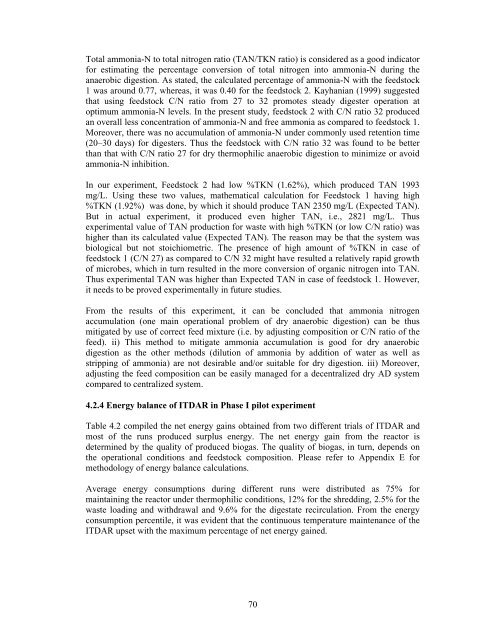dry anaerobic digestion of municipal solid waste and digestate ...
dry anaerobic digestion of municipal solid waste and digestate ...
dry anaerobic digestion of municipal solid waste and digestate ...
You also want an ePaper? Increase the reach of your titles
YUMPU automatically turns print PDFs into web optimized ePapers that Google loves.
Total ammonia-N to total nitrogen ratio (TAN/TKN ratio) is considered as a good indicator<br />
for estimating the percentage conversion <strong>of</strong> total nitrogen into ammonia-N during the<br />
<strong>anaerobic</strong> <strong>digestion</strong>. As stated, the calculated percentage <strong>of</strong> ammonia-N with the feedstock<br />
1 was around 0.77, whereas, it was 0.40 for the feedstock 2. Kayhanian (1999) suggested<br />
that using feedstock C/N ratio from 27 to 32 promotes steady digester operation at<br />
optimum ammonia-N levels. In the present study, feedstock 2 with C/N ratio 32 produced<br />
an overall less concentration <strong>of</strong> ammonia-N <strong>and</strong> free ammonia as compared to feedstock 1.<br />
Moreover, there was no accumulation <strong>of</strong> ammonia-N under commonly used retention time<br />
(20–30 days) for digesters. Thus the feedstock with C/N ratio 32 was found to be better<br />
than that with C/N ratio 27 for <strong>dry</strong> thermophilic <strong>anaerobic</strong> <strong>digestion</strong> to minimize or avoid<br />
ammonia-N inhibition.<br />
In our experiment, Feedstock 2 had low %TKN (1.62%), which produced TAN 1993<br />
mg/L. Using these two values, mathematical calculation for Feedstock 1 having high<br />
%TKN (1.92%) was done, by which it should produce TAN 2350 mg/L (Expected TAN).<br />
But in actual experiment, it produced even higher TAN, i.e., 2821 mg/L. Thus<br />
experimental value <strong>of</strong> TAN production for <strong>waste</strong> with high %TKN (or low C/N ratio) was<br />
higher than its calculated value (Expected TAN). The reason may be that the system was<br />
biological but not stoichiometric. The presence <strong>of</strong> high amount <strong>of</strong> %TKN in case <strong>of</strong><br />
feedstock 1 (C/N 27) as compared to C/N 32 might have resulted a relatively rapid growth<br />
<strong>of</strong> microbes, which in turn resulted in the more conversion <strong>of</strong> organic nitrogen into TAN.<br />
Thus experimental TAN was higher than Expected TAN in case <strong>of</strong> feedstock 1. However,<br />
it needs to be proved experimentally in future studies.<br />
From the results <strong>of</strong> this experiment, it can be concluded that ammonia nitrogen<br />
accumulation (one main operational problem <strong>of</strong> <strong>dry</strong> <strong>anaerobic</strong> <strong>digestion</strong>) can be thus<br />
mitigated by use <strong>of</strong> correct feed mixture (i.e. by adjusting composition or C/N ratio <strong>of</strong> the<br />
feed). ii) This method to mitigate ammonia accumulation is good for <strong>dry</strong> <strong>anaerobic</strong><br />
<strong>digestion</strong> as the other methods (dilution <strong>of</strong> ammonia by addition <strong>of</strong> water as well as<br />
stripping <strong>of</strong> ammonia) are not desirable <strong>and</strong>/or suitable for <strong>dry</strong> <strong>digestion</strong>. iii) Moreover,<br />
adjusting the feed composition can be easily managed for a decentralized <strong>dry</strong> AD system<br />
compared to centralized system.<br />
4.2.4 Energy balance <strong>of</strong> ITDAR in Phase I pilot experiment<br />
Table 4.2 compiled the net energy gains obtained from two different trials <strong>of</strong> ITDAR <strong>and</strong><br />
most <strong>of</strong> the runs produced surplus energy. The net energy gain from the reactor is<br />
determined by the quality <strong>of</strong> produced biogas. The quality <strong>of</strong> biogas, in turn, depends on<br />
the operational conditions <strong>and</strong> feedstock composition. Please refer to Appendix E for<br />
methodology <strong>of</strong> energy balance calculations.<br />
Average energy consumptions during different runs were distributed as 75% for<br />
maintaining the reactor under thermophilic conditions, 12% for the shredding, 2.5% for the<br />
<strong>waste</strong> loading <strong>and</strong> withdrawal <strong>and</strong> 9.6% for the <strong>digestate</strong> recirculation. From the energy<br />
consumption percentile, it was evident that the continuous temperature maintenance <strong>of</strong> the<br />
ITDAR upset with the maximum percentage <strong>of</strong> net energy gained.<br />
70

















